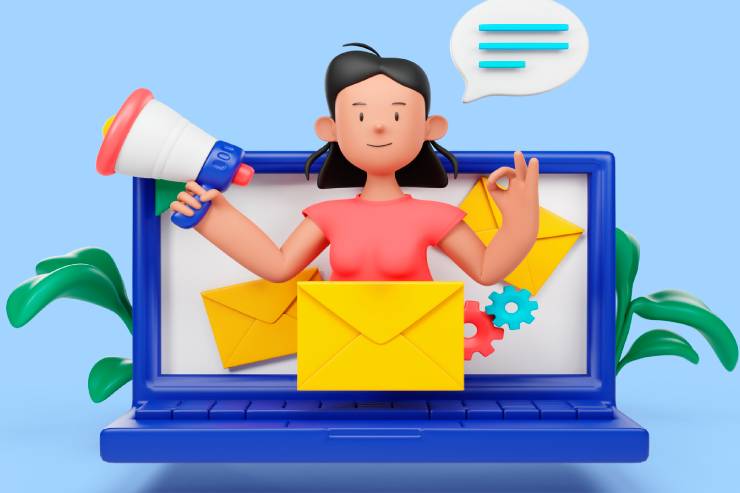
Email marketing has stood the test of time, remaining a powerful tool in a marketer’s arsenal despite the ever-evolving digital landscape. However, the future of email marketing looks quite different from its humble beginnings. To stay ahead of the curve and continue reaping the benefits of this cost- effective marketing channel, understanding emerging trends is crucial.
This article delves into the key trends shaping the future of email marketing, equipping you with the knowledge to craft successful campaigns that resonate with your audience.
1. Hyper-Personalization Takes Center Stage
Personalization has long been a buzzword in marketing, and email marketing is no exception. Consumers today expect a tailored experience, and emails that feel generic or irrelevant will likely find their way to the dreaded spam folder.
The future of email marketing lies in hyper-personalization, leveraging data to create highly targeted and relevant content for individual subscribers. This includes:
Dynamic Content: Populate emails with subscriber-specific information like names, purchase history, and past interactions to create a one-on-one feel.
Behavioural Targeting: Segment your audience based on past behavior (abandoned carts, website visits, clicked links) and tailor
content accordingly.
Predictive Analytics: Utilize data to predict subscriber preferences and suggest products, services, or content they might be interested in.
Benefits: Increased engagement, click-through rates, and conversions. Subscribers feel valued and are more likely to perceive your emails as helpful rather than intrusive.
Example: An e-commerce store can send personalized emails to customers who recently abandoned their cart, featuring the abandoned items or similar products.
2. Interactive Elements Enhance Engagement
Static text-heavy emails are a thing of the past. The future of email marketing embraces interactivity to capture subscriber attention and create a more engaging experience. Consider incorporating these elements:
Polls and Surveys: Encourage feedback directly within the email, allowing subscribers to voice their opinions or preferences.
Product Carousels: Showcase multiple products without overwhelming subscribers, allowing them to browse quickly within the
email itself.
Interactive Buttons and CTAs: Integrate buttons that open product pages, booking forms, or other interactive elements with a single click.
Benefits: Increased user engagement, valuable customer insights, and a more dynamic email experience that feels less like marketing and more like a two-way conversation.
Example: A travel company can send an email with an interactive map, allowing subscribers to explore different destinations and learn more about specific tour packages.
3. Voice-Activated Email Takes Hold
The rise of smart speakers and voice assistants like Alexa and Siri is paving the way for a future where users interact with email via voice commands. Imagine opening an email and being able to add items to a shopping cart or book an appointment simply by speaking.
Although still in its nascent stages, voice-activated email holds immense potential to improve accessibility and streamline user interaction.
Benefits: Increased convenience for users, particularly those who prefer voice interaction or have accessibility limitations.
Challenges: Optimization for voice search and ensuring emails are easily navigable with voice commands.
4. Augmented Reality (AR) Blurs the Lines Between Physical and Digital
Augmented reality (AR) has the potential to revolutionize the email marketing landscape. Imagine receiving an email with a product embedded that you can virtually “try on” with your smartphone camera, or an email that allows you to explore a virtual showroom of furniture before making a purchase.
While widespread adoption of AR might be some time away, forward-thinking brands can experiment with this technology to create truly immersive and interactive email experiences.
Benefits: Increased product engagement, improved product visualization, and a more memorable email experience.
Challenges: Technical limitations of smartphone technology and ensuring smooth user experience across all devices.
Example: A clothing brand can send an email featuring AR technology that allows subscribers to virtually try on clothes in different sizes and colors.
5. Artificial Intelligence (AI) Streamlines Workflows and Personalizes Content
Artificial intelligence (AI) has the potential to significantly impact email marketing in several ways:
Automated Content Creation: AI can analyze data and generate personalized subject lines, email copy, and product recommendations
for each subscriber.
Improved Design and Optimization: AI can optimize email design for different devices and predict which elements will lead to higher
engagement.
Real-Time Personalization: AI can analyze subscriber behaviour in real-time and tailor content based on their most recent actions and
interests.
Benefits: Increased efficiency, improved personalization, and better overall campaign performance.
Challenges: Ensuring AI-generated content retains a human touch and avoids sounding robotic.
 Your Success, Our Priority: Our team is here to assist you!
Your Success, Our Priority: Our team is here to assist you!





